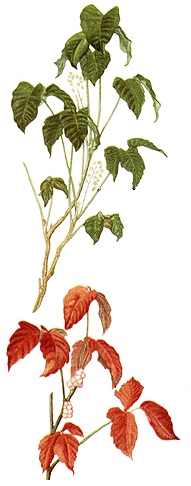Site Links:
A quick overview of poison ivy, oak, and sumac facts and myths.
A general discussion how oil is removed by soaps or solvents and how different products may work.
A collection of pictures identifying poison ivy, poison oak and poison sumac. Pictures are being added which detail the changes in the plants in the various seasons. There are also links to other great sites which have more photos.
A list of commercial products available to treat the Urushiol-induced rash with links to the product site. There is also a small list of viewer recommended products.
A very LARGE list of commercial and home remedies, regimens, and treatment ideas for dealing with an allergic reaction to poison ivy, oak, or sumac suggested by our viewers.
A place where viewers can ask and answer questions about poison ivy, and its cousins.
Questions we've received about poison ivy, oak or sumac with answers.
Frequently Asked Questions about identifying and controlling poison ivy, oak, and sumac as well as identifying and treating the rash.
Lots of great links to other poison ivy, oak or sumac related sites grouped by category. Find treatments, quizzes, rash identification, control methods and more.
Some suggestions on controlling poison ivy, oak and sumac plants. If you're lucky you may be able to fully remove the plants - I've only been able to get them under control.
Links to predefined queries of popular search engines. Find info on poison ivy fast.
A listing of books available from Amazon about poison ivy, poison oak, and poison sumac identification, treatment, and control.
Listing of the entire Poison Ivy, Oak, and Sumac Information Center website.
There are many ways that you can help this site. Please consider helping out to keep the Poison Ivy, Oak, and Sumac Information Center running.
General Discussion
Poison ivy is a harmful vine or shrub in the cashew family.
It grows plentifully in parts of the United States and southern
Canada. Poison ivy usually grows as a vine twining on tree trunks or
straggling over the ground. But the plant often forms upright bushes
if it has no support to climb upon. Species related to poison ivy
include poison oak, which grows in the Pacific Northwest and nearby
regions of Canada, and poison sumac, which grows in the Eastern
United States. Poison oak and poison sumac both are shrubs.
The tissues of all these plants contain a poisonous oil somewhat
like carbolic acid. This oil is extremely irritating to the skin. It
may be brushed onto the clothing or skin of people coming in
contact with the plants. Many people have been poisoned merely by
taking off their shoes after walking through poison ivy. People can
get poisoned from other people, but only if the oil remains on their
skin. The eruptions themselves are not a source of infection.
Appearance - the leaves of poison ivy are red in early spring. Later
in spring, they change to shiny green. They turn yellow, red or orange in
autumn. Each leaf is made up of three leaflets more or less notched
at the edges. Two of the leaflets form a pair on opposite sides of
the leafstalk, while the third stands by itself at the tip of the
leafstalk. Small greenish flowers grow in bunches attached to the
main stem close to where each leaf joins it. Later in the season,
clusters of poisonous, berry-like drupes form. They are whitish, with
a waxy look.
Control and treatment: Efforts have been made to destroy these
plants by uprooting them or by spraying them with chemicals. But
poison ivy and poison oak are so common that such methods have not
been very effective in eliminating them. Contact with the plants
should be avoided.
After the oil has touched the skin, it usually takes some time for
it to penetrate and do its damage. Before this happens, it is wise
to wash the skin thoroughly several times with plenty of soap and
water. Care should be taken not to touch any part of the body, for
even tiny amounts of the oil will cause irritation.
If poisoning develops, the blisters and red, itching skin may be
treated with dressings of calamine lotion, Epsom salts, or
bicarbonate of soda. Scientists have developed a vaccine that can be
injected or swallowed. But this is effective only if taken before
exposure.
Scientific Classification. Poison ivy, poison oak, and poison sumac
belong to the cashew family, Anacardiaceae. Poison ivy is classified
as Rhus radicans or Toxicondendron radicans. Poison oak is R.
diversiloba or T. diversilobum and poison sumac is R. vernix or T.
vernix.
About This Site
This web site is dedicated to those individuals that have ever
experienced and suffered through the itching and painful rashes associated
with contact of an oil called urushiol (you-ROO-shee-ol) from
these plants. We hope that you will find relief in the pages on this site.
|



